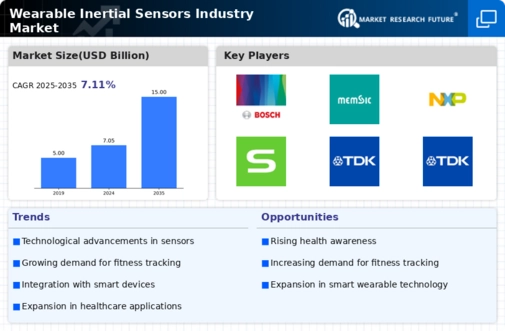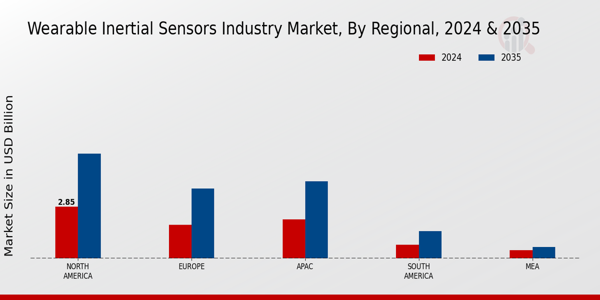Market Growth Projections
The Global Wearable Inertial Sensors Industry Market is projected to experience substantial growth over the next decade. The market is expected to reach 7.05 USD Billion in 2024 and is anticipated to expand to 15 USD Billion by 2035. This growth trajectory suggests a compound annual growth rate of 7.1% from 2025 to 2035. Such projections indicate a robust demand for wearable inertial sensors across various sectors, including healthcare, fitness, and personal safety. The increasing integration of these sensors into consumer electronics and the rising awareness of health and fitness trends are likely to sustain this upward momentum.
Increasing Adoption in Sports and Fitness
The Global Wearable Inertial Sensors Industry Market is significantly influenced by the increasing adoption of wearable technology in sports and fitness applications. Athletes and fitness enthusiasts utilize these devices to monitor performance metrics, such as speed, acceleration, and movement patterns. This trend is supported by the growing awareness of the benefits of data-driven training regimens. As a result, the market is expected to witness a compound annual growth rate of 7.1% from 2025 to 2035. The integration of inertial sensors into sports gear and fitness trackers enhances training efficiency and injury prevention, thereby driving the Global Wearable Inertial Sensors Industry Market.
Rising Demand for Health Monitoring Devices
The Global Wearable Inertial Sensors Industry Market is experiencing a surge in demand for health monitoring devices. As consumers increasingly prioritize health and wellness, wearable technology that tracks physical activity, heart rate, and other vital signs is becoming essential. In 2024, the market is projected to reach 7.05 USD Billion, reflecting a growing trend towards preventive healthcare. This shift is driven by the need for real-time health data, which wearable inertial sensors provide. The integration of these sensors into fitness trackers and smartwatches enhances user engagement and encourages healthier lifestyles, thereby propelling the Global Wearable Inertial Sensors Industry Market forward.
Growing Focus on Personal Safety and Security
The Global Wearable Inertial Sensors Industry Market is also driven by a growing focus on personal safety and security. Wearable devices equipped with inertial sensors are increasingly being utilized for personal safety applications, such as fall detection and emergency alerts. This trend is particularly relevant for elderly individuals and those with health concerns, as these devices can provide timely assistance in critical situations. The rising awareness of personal safety issues is likely to propel the market forward, as consumers seek reliable solutions to enhance their security. This focus on safety is expected to contribute to the overall growth of the Global Wearable Inertial Sensors Industry Market.
Expansion of Internet of Things (IoT) Ecosystem
The expansion of the Internet of Things (IoT) ecosystem is a significant driver of the Global Wearable Inertial Sensors Industry Market. As more devices become interconnected, the demand for wearable sensors that can seamlessly integrate with other IoT devices is increasing. This connectivity allows for enhanced data sharing and analysis, providing users with comprehensive insights into their health and activity levels. The growing trend of smart homes and connected health devices further supports this market expansion. The Global Wearable Inertial Sensors Industry Market is poised to benefit from this interconnectedness, as it fosters innovation and enhances user experience.
Technological Advancements in Sensor Technology
Technological advancements play a crucial role in the growth of the Global Wearable Inertial Sensors Industry Market. Innovations in sensor miniaturization, accuracy, and energy efficiency are enabling the development of more sophisticated wearable devices. For instance, the incorporation of advanced algorithms and machine learning enhances the functionality of inertial sensors, allowing for more precise motion tracking and data analysis. As these technologies evolve, they are likely to attract a broader consumer base, contributing to an anticipated market growth to 15 USD Billion by 2035. This continuous improvement in sensor technology is a key driver of the Global Wearable Inertial Sensors Industry Market.













